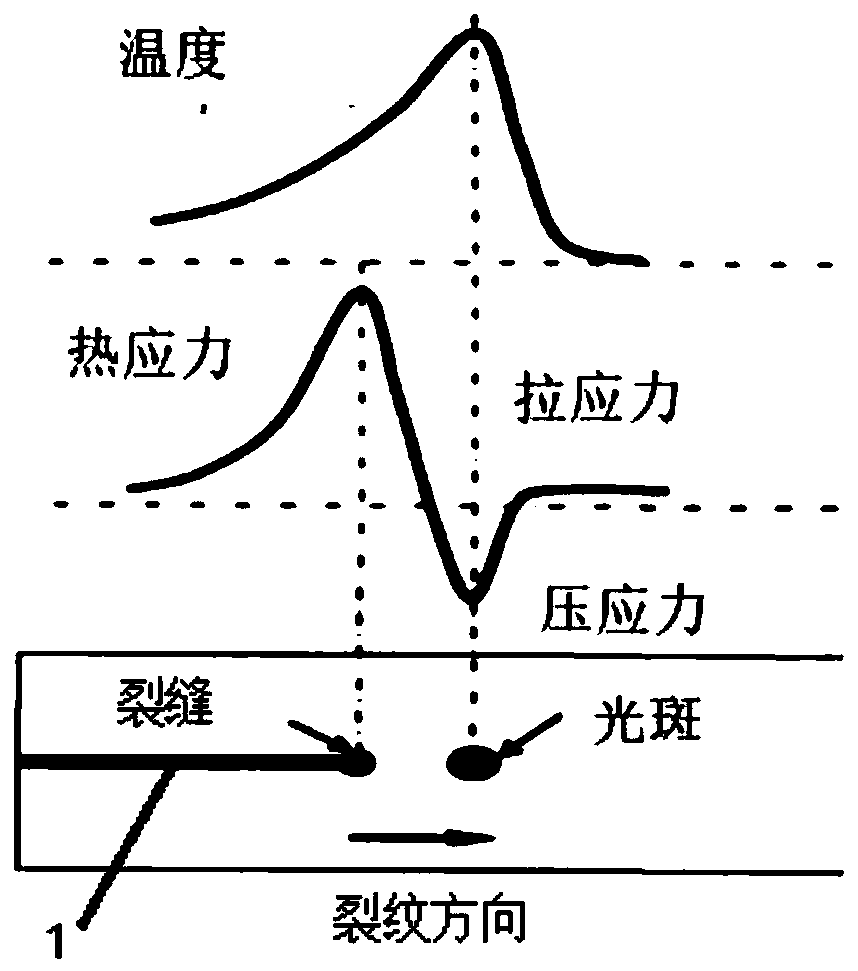Photovoltaic cell cutting method and cell manufactured by method
A technology of photovoltaic cells and cutting methods, applied in manufacturing tools, semiconductor/solid-state device manufacturing, circuits, etc., can solve problems such as adverse effects of equipment working environment, reduced efficiency of hit cells, and reduced package power of components, so as to increase power and reduce Effects of destroying and improving mechanical strength
- Summary
- Abstract
- Description
- Claims
- Application Information
AI Technical Summary
Problems solved by technology
Method used
Image
Examples
Embodiment 1
[0032] A method for cutting photovoltaic cells, comprising the steps of:
[0033] 1. Place the cell to be cut in the laser scribing area;
[0034] 2. Use the first laser to form the first cutting line 1 on the edge of the cell at the cell cutting position. The length of the crack in the first cutting line 1 is 0.3 cm, and the cutting depth is 70% of the thickness of the cell;
[0035] 3. Using the second laser, the spot is heated along the first cutting line 1 in front of the crack. The principle can be referred to figure 1 , an uneven temperature field and temperature gradient are formed at the spot position, and the temperature gradient induces the generation of thermal stress, so that the crack cracks the battery sheet along the moving direction of the spot;
[0036] When the light spot acts on the silicon wafer, the cutting position is cooled by air cooling at the same time to reduce the temperature at which the laser reaches the surface of the battery. In this example, t...
Embodiment 2
[0040] A method for cutting photovoltaic cells, comprising the steps of:
[0041] 1. Place the cell to be cut in the laser scribing area;
[0042] 2. Use the first laser to form the first cutting line 1 on the edge of the cell at the cell cutting position. The length of the crack in the first cutting line 1 is 2.5 cm, and the cutting depth is 50% of the thickness of the cell;
[0043] 3. Using the second laser, the spot is heated along the first cutting line 1 in front of the crack. The principle can be referred to figure 1 , an uneven temperature field and temperature gradient are formed at the spot position, and the temperature gradient induces the generation of thermal stress, so that the crack cracks the battery sheet along the moving direction of the spot;
[0044] When the light spot acts on the silicon wafer, liquid cooling is used to cool the cutting position at the same time, so as to reduce the temperature at which the laser reaches the surface of the battery. In th...
Embodiment 3
[0048] A method for cutting photovoltaic cells, comprising the steps of:
[0049]1. Place the cell to be cut in the laser scribing area;
[0050] 2. Use the first laser to form the first cutting line 1 on the edge of the cell at the cutting position of the cell. The length of the crack in the first cutting line 1 is 3 cm, and the cutting depth is 60% of the thickness of the cell;
[0051] 3. Using the second laser, the spot is heated locally in front of the crack along the first cutting line 1, forming an uneven temperature field and temperature gradient at the spot position, and the temperature gradient induces thermal stress, so that the crack along the The direction in which the light spot moves splits the cell;
[0052] When the light spot acts on the silicon wafer, the cutting position is cooled by air cooling at the same time to reduce the temperature at which the laser reaches the surface of the battery. The second laser cutting temperature is lower than 200°C, and the...
PUM
| Property | Measurement | Unit |
|---|---|---|
| length | aaaaa | aaaaa |
| length | aaaaa | aaaaa |
| length | aaaaa | aaaaa |
Abstract
Description
Claims
Application Information
 Login to View More
Login to View More - R&D
- Intellectual Property
- Life Sciences
- Materials
- Tech Scout
- Unparalleled Data Quality
- Higher Quality Content
- 60% Fewer Hallucinations
Browse by: Latest US Patents, China's latest patents, Technical Efficacy Thesaurus, Application Domain, Technology Topic, Popular Technical Reports.
© 2025 PatSnap. All rights reserved.Legal|Privacy policy|Modern Slavery Act Transparency Statement|Sitemap|About US| Contact US: help@patsnap.com



